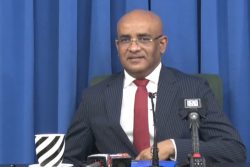– stresses importance of transparency
In a unanimous ruling, the Caribbean Court of Justice (CCJ) on Thursday dismissed an appeal filed by political commentator and activist Ramon Gaskin, who for years had contended that separate environmental permits ought to have been granted to Hess Guyana Exploration Ltd (Hess) and China National Offshore Oil Cooperation Guyana (CNOOC) for their involvement in oil production here.
In affirming the rulings of both the local high and appellate courts, however, the Trinidad-based CCJ—Guyana’s final appellate court—was clear in pointing out that as “developer” of the specific “project” undertaken, it was only ExxonMobil which needed to have been licensed and not Hess and CNOOC as well.
This was a pronouncement repeatedly made by the lower courts and emphasised on Thursday by the five judges constituting the panel which heard Gaskin’s challenge in Trinidad.
 While it dismissed his appeal, however, the Court was keen in pronouncing that Hess and CNOOC could not carry out activities which may significantly impact the environment, noting that Exxon can be criminally sanctioned if it allowed them to do so.
While it dismissed his appeal, however, the Court was keen in pronouncing that Hess and CNOOC could not carry out activities which may significantly impact the environment, noting that Exxon can be criminally sanctioned if it allowed them to do so.
It also underscored the importance of transparency and accountability by the corporations involved; even as it commended Gaskin for being a public-spirited citizen zealous for compliance with the constitutional and statutory principles and provisions protecting the environment.
Gaskin’s firm position since he instituted the proceedings back in 2016, had been that the single environmental permit granted to ExxonMobil’s local subsidiary Esso Exploration and Production Guyana Limited (Esso), could not by extension cover Hess and CNOOC.
He had challenged the Petroleum Production Licence (PPL) issued to Hess and CNOOC by former Minister of Natural Resources Raphael Trotman, whom he said ought not to have made the grant, since they did not have separate environmental permits.
Back in February of 2020, acting Chief Justice Roxane George SC threw out the case, ruling that Hess and CNOOC did not need separate environmental permits from co-venturer ExxonMobil/Esso who was the developer, to conduct oil production here.
Dissatisfied with the Chief Justice’s ruling in which he said a number of legal errors were made, Gaskin appealed to the Guyana Court of Appeal, but was also unsuccessful in persuading that court that Hess and CNOOC needed separate permits.
It was this ruling that then precipitated his challenge to the CCJ.
The court of last resort on Thursday, however, affirmed those two earlier rulings.
In determining whether the Minister acted unlawfully in granting the PPL to Hess and CNOOC when only Exxon was granted an environmental permit; the CCJ said that the grant of the single licence under which CNOOC and Hess were covered did not render the licence invalid.
In delivering the judgment of the court, Justice Winston Anderson deferred to Articles 25, 36 and 149J of Guyana’s Constitution which he noted expressly provides for environmental rights, placing protection of the environment upon an exalted plane.
These provisions he said, must be borne in mind when interpreting legislation that touch and concern the environment. He then went on to point that under Sections 14 and 4(5) of the Environmental Protection Act, the granting of environmental authorisation was a condition precedent to the power exercisable by the Minister under Section 35 of the Petroleum (Exploration and Production) Act (PEP Act) to grant a PPL.
Justice Anderson said that in interpreting the Environmental Protection Act as a whole and within the context of its objectives and constitutional underpinnings, it can be concluded that environmental authorisation must be given for the undertaking of a project and that the Environmental Protection Agency must be convinced that a developer can fulfil their role and responsibilities and comply with the terms and conditions of the environmental permit.
“As sole operator, Exxon alone was able to comply with the obligations of the developer under the Environmental Pro-tection Act,” he noted in the written judgement.
In presenting the summary of the court’s judgment, Justice Anderson pointed out that in the case in question, the PPL had been granted on the basis that ExxonMobil was the operator of the project and was subject to extensive environmental obligations which were extended to Hess and CNOOC through joint and several liability.
The grant of the Licence to CNOOC and Hess he went on to say, did not render the licence invalid for four reasons.
Firstly, he said that the essential requirements under Section 14 of the Environmental Protection Act to obtain an Environmental Permit had been satisfied with the grant of the environmental permit to the sole operator of the Liza 1 Project.
Secondly, he said it was consistent with international oil and gas industry practice that Exxon as operator functioned as representative of the joint venturers and that Hess and CNOOC be included within the licence as financial partners to secure financing.
The Judge said that thirdly, Exxon, Hess and CNOOC shared liability for environmental harm guaranteed by their joint and separate liability; and that fourthly, there was no increased risk of harm to the environment under either the precautionary principle or avoidance principle by the inclusion of Hess and CNOOC in the licence.
Contemplation
For his part, President of the court, Justice Adrian Saunders who also presided over the appeal, reasoned that the environmental permit was obtained in contemplation of works that placed the environment at risk to be undertaken solely by Exxon.
“It is only necessary that those co-venturers who were to be engaged in development activity that may have a significant impact upon the environment should be granted an environmental permit,” he said.
Justice Saunders then went on to add that given that a) the liabilities undertaken in connection with the licence are joint and several; b) Exxon (and not CNOOC nor Hess) was the developer carrying out day to day activities; c) neither the grant of the permit nor of the licence, in each case to Exxon, is being challenged and d) no grounds were advanced to impugn either of those two authorisations to Exxon; “it could not fairly be said that, in licensing CNOOC and Hess, the Minister acted illegally or irrationally or unfairly or unreasonably.”
The Court concluded that there was no basis for finding that the Minister acted unlawfully and thus considered it unnecessary to address the issue of amendment of grounds of relief pleaded while noting; “as the appellant had acted as a public-spirited citizen intent on advancing the constitutional protection of the environment costs ought not be awarded against him.”
In a concurring judgment, Justice Maureen Rajnauth-Lee, another of the judges on the panel, said that in interpreting the relevant statute, the question of whether an environmental permit approves a project or an applicant undertaking the project, ought not to be bifurcated.
On this point she said that the Environ-mental Protection Act did not envision a multiplicity of applications. “Accordingly, there was nothing in the Act requiring CNOOC and Hess to make separate applications for an environmental permit,” she said.
Justice Rajnauth-Lee said that Guy-ana’s Constitution and its international obligations required balancing of sustainable development and the use of natural resources, with justifiable economic and social development, to safeguard the environment for the benefit of future generations.
She was therefore of the view that the objectives of the Environmental Protec-tion Act, particularly the environmental protection and the sustainable development and use of the natural resources of Guyana, were fully satisfied by the grant of the Licence to Hess and CNOOC.
She, too, said that there was no increas-ed risk of harm to the environment by the inclusion of CNOOC and Hess in the licence and further emphasised the role of the public in the decision-making process in environmental matters in accordance with the Rio Declaration.
Consequences flow
The apex court was nonetheless swift to point out that Hess and CNOOC were not the developer and therefore could not operate as such as two consequences flow from the award of the permit only to Exxon.
It said that firstly, CNOOC and Hess, having not been included in the permit, will have to abide strictly by the notion that their part in the venture or project will not include the activities of a developer.
The Court said, “they are not permitted to engage in any activity that may significantly impact the environment without the prior consent of the Environmental Protection Agency (EPA) as that would amount to an unlawful transfer or assignment of the permit. If Exxon permitted any such thing, as earlier indicated, under s 21(9)(a) of the EPA, Exxon will be exposed to criminal sanctions.”
“Secondly, Exxon, whether jointly with its co-venturers or otherwise, remains liable to the State for all the obligations and requirements imposed by the permit.”
Meanwhile, regarding its comments on transparency and accountability, the Court said it was necessary to emphasise that the Appellant’s grave fears alluded to are not to be derided or brushed aside.
“They are risks that naturally attend subsea drilling,” the Court said, while adding that corporations, government agencies (like the EPA), and other public entities have a solemn obligation to hold themselves accountable for the steps they take in the management, conservation, protection and improvement of the environment.
“There must be scrupulous compliance with relevant statutes and regulations. Good governance, fairness and the utmost transparency must be observed. In this regard, information about policies and decisions, applications and applicants must be readily made available to the public,” the CCJ said.
The Court then went on to add, “transparency promotes trust and facilitates public participation in environmental decision-making processes. When information about environmental policies, regulations, applications for permits and enforcement actions is readily available, it becomes easier for the public to identify instances of non-compliance or
misconduct and for the EPA and other bodies to take appropriate corrective action. A demonstrated commitment to openness and accountability is especially required given the massive investment in subsea drilling for oil currently underway in Guyana.”
The apex court concluded that there was no basis for finding that the Minister acted unlawfully and thus considered it unnecessary to address the issue of amendment of grounds of relief pleaded.
It ordered that the appeal be dismissed but said it found that Gaskin acted as “a public-spirited citizen intent on advancing the constitutional protection of the environment,” declaring that costs not be awarded against him but instead each party bear its costs.
Following the ruling, Melinda Janki, one of Gaskin’s attorneys, expressed disappointment that the court did not ultimately rule in her client’s favour, but said that Gaskin is an inspiration when it comes to advocating for and safeguarding the environment.
“I am obviously disappointed that the CCJ did not ultimately accept our arguments that the Minister acted unlawfully in granting a petroleum production licence to Hess and CNOOC who do not have an environmental permit,” she told Stabroek News.
She then went on to add, “however I welcome the Court’s statements on the importance of transparency and accountability, not just in government but also for corporations operating in Guyana. I am especially pleased to see the Court recognise our client Ramon Gaskin as a public-spirited citizen who has contributed to the development of environmental law in Guyana. Mr Gaskin is an inspiration to all who believe in the rule of law and in taking action to protect Guyana.”
The appeal was heard by Justices Saunders, Anderson, and Rajnauth-Lee; together with Justices Andrew Burgess and Denys Barrow.
Background
The battery of attorneys which represented Hess and CNOOC had strongly refuted the position advanced by Gaskin.
When the matter came up for hearing back in February, Senior Counsel Seenath Jairam who represents Gaskin, had told the apex court that since it was Esso which had been granted an environmental permit, the Minister, in accordance with Section 14 of the Environmental Protec-tion Act, was proper in granting a petroleum production licence to Esso alone.
In the summary of his presentation, he advanced that given the peculiar circumstances, Esso would have authorisation to continue with its petroleum operations, subject to the law, pending environmental permits also being lawfully granted to Hess and CNOOC.
In their submissions to the Court, however, the battery of attorneys for the Minister, led by Senior Counsel Edward Luckhoo, had advanced that the environmental permit was issued in relation to a project and that it was not necessary for it to be issued to each company which is a party to the petroleum agreement for the execution of the project.
On this point he reasoned that nowhere can it be legally substantiated that a PPL is to be granted to each of the three companies; even as he made the point that the licence when issued was for the consortium—the project—and not every company involved.
Attorney Sanjeev Datadin for the EPA, which appeared amicus in the proceedings, expressed the same sentiments.
Referencing the rulings of both the High Court and the Court of Appeal, Luckhoo, as did Senior Counsel Andrew Pollard for Esso, CNOOC and Hess; said that Section 10 of the Act, defines developer to mean, “the applicant for environmental authorization for a project or the State initiating a project.”
Pollard had advanced that it was Esso which was the developer and that Hess and CNOOC were mere financiers of the project and not involved of the actual exploration operation.










